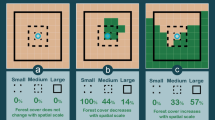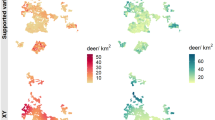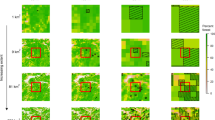Abstract
Species distribution models (SDMs) are popular in conservation and management of a wide array of taxa. Often parameterized with coarse GIS-based environmental maps, they perform well in macro-ecological settings but it is debated if the models can predict distribution within broadly suitable “known” habitats of interest to local managers. We parameterized SDMs with GIS-derived environmental variables and location data from 82 GPS-collared female red deer (Cervus elaphus) from two study areas in Norway. Candidate GLM models were fitted to address the effect of spatial scale (landscape vs. home range), sample size, and transferability between study areas, with respect to predictability (AUC) and explained variance (Generalized R 2 and deviance). The landscape level SDM captured variation in deer distribution well and performed best on all diagnostic measures of model quality, caused mainly by a trivial effect of avoidance of non-habitat (barren mountains). The home range level SDMs were far less predictable and explained comparatively little variation in space use. Landscape scale models stabilized at the low sample size of 5–10 individuals and were highly transferrable between study areas implying a low degree of individual variation in habitat selection at this scale. It is important to have realistic expectations of SDMs derived from digital elevation models and coarse habitat maps. They do perform well in highlighting potential habitat on a landscape scale, but often miss nuances necessary to predict more fine-scaled distribution of wildlife populations. Currently, there seems to be a trade-off between model quality and usefulness in local management.



Similar content being viewed by others
References
Abrahamsen J, Jacobsen NK, Kalliola R, Dahl E, Wilborg L, Pahlsson L (1977) Naturgeografisk region-inndeling av Norden. Nord Utredning B 34:1–135
Albon SD, Langvatn R (1992) Plant phenology and the benefits of migration in a temperate ungulate. Oikos 65:502–513
Andelman SJ, Willig MR (2002) Alternative configurations of conservation reserves for Paraguayan bats: considerations of spatial scale. Conserv Biol 16(5):1352–1363
Austin MP (2002) Spatial prediction of species distribution: an interface between ecological theory and statistical modelling. Ecol Model 157(2–3):101–118
Austin M (2007) Species distribution models and ecological theory: a critical assessment and some possible new approaches. Ecol Model 200(1–2):1–19
Berg A, Gardenfors U, von Proschwitz T (2004) Logistic regression models for predicting occurrence of terrestrial molluscs in southern Sweden—importance of environmental data quality and model complexity. Ecography 27(1):83–93
Betts MG, Diamond AW, Forbes GJ, Villard MA, Gunn JS (2006) The importance of spatial autocorrelation, extent and resolution in predicting forest bird occurrence. Ecol Model 191(2):197–224
Beyer HL (2004) Hawth’s analysis tools for ArcGIS. Available at http://www.spatialecology.com/htools
Bjorneraas K, Van Moorter B, Rolandsen CM, Herfindal I (2010) Screening global positioning system location data for errors using animal movement characteristics. J Wildl Manag 74(6):1361–1366
Boyce MS, Vernier PR, Nielsen SE, Schmiegelow FKA (2002) Evaluating resource selection functions. Ecol Model 157(2–3):281–300
Boyce MS, Mao JS, Merrill EH, Fortin D, Turner MG, Fryxell J, Turchin P (2003) Scale and heterogeneity in habitat selection by elk in Yellowstone National Park. Ecoscience 10(4):421–431
Brambilla M, Casale F, Bergero V, Crovetto GM, Falco R, Negri I, Siccardi P, Bogliani G (2009) GIS-models work well, but are not enough: habitat preferences of Lanius collurio at multiple levels and conservation implications. Biol Conserv 142(10):2033–2042
Burnham KP, Anderson DR (1998) Model selection and inference: a practical information-theoretic approach. Springer, New York
Calenge C, Darmon G, Basille M, Loison A, Jullien JM (2008) The factorial decomposition of the Mahalanobis distances in habitat selection studies. Ecology 89(2):555–566
D’Eon RG (2003) Effects of a stationary GPS fix-rate bias on habitat selection analyses. J Wildl Manag 67(4):858–863
D’Eon RG, Delaparte D (2005) Effects of radio-collar position and orientation on GPS radio-collar performance, and the implications of PDOP in data screening. J Appl Ecol 42(2):383–388
D’Eon RG, Serrouya R (2005) Mule deer seasonal movements and multiscale resource selection using global positioning system radiotelemetry. J Mammal 86(4):736–744
Dettki H, Lofstrand R, Edenius L (2003) Modeling habitat suitability for moose in coastal northern Sweden: empirical vs process-oriented approaches. Ambio 32(8):549–556
Elith J, Graham CH (2009) Do they? How do they? WHY do they differ? On finding reasons for differing performances of species distribution models. Ecography 32(1):66–77
Elith J, Leathwick JR (2009) Species distribution models: ecological explanation and prediction across space and time. Annu Rev Ecol Evol Syst 40:677–697
Frair JL, Nielsen SE, Merrill EH, Lele SR, Boyce MS, Munro RHM, Stenhouse GB, Beyer HL (2004) Removing GPS collar bias in habitat selection studies. J Appl Ecol 41(2):201–212
Gaillard JM, Hebblewhite M, Loison A, Fuller M, Powell R, Basille M, Van Moorter B (2010) Habitat-performance relationships: finding the right metric at a given spatial scale. Philos Trans R Soc B Biol Sci 365(1550):2255–2265
Getz WM, Wilmers CC (2004) A local nearest-neighbor convex-hull construction of home ranges and utilization distributions. Ecography 27(4):489–505
Gillingham MP, Parker KL (2008) The importance of individual variation in defining habitat selection by moose in northern British Columbia. Alces 44:7–20
Godvik IM, Loe LE, Vik JO, Veiberg V, Langvatn R, Mysterud A (2009) Temporal scales, trade-offs and functional responses in red deer habitat selection. Ecology 90(3):699–710
Guisan A, Thuiller W (2005) Predicting species distribution: offering more than simple habitat models. Ecol Lett 8(9):993–1009
Guisan A, Zimmermann NE (2000) Predictive habitat distribution models in ecology. Ecol Mod 135:147–186
Guisan A, Graham CH, Elith J, Huettmann F, Distri NS (2007) Sensitivity of predictive species distribution models to change in grain size. Divers Distrib 13(3):332–340. doi:10.1111/j.1472-4642.2007.00342.x
Gustine DD, Parker KL, Lay RJ, Gillingham MP, Heard DC (2006) Interpreting resource selection at different scales for woodland caribou in winter. J Wildl Manag 70(6):1601–1614
Hebblewhite M, Haydon DT (2010) Distinguishing technology from biology: a critical review of the use of GPS telemetry data in ecology. Philos Trans R Soc B Biol Sci 365:2303–2312
Hirzel AH, Le Lay G (2008) Habitat suitability modelling and niche theory. J Appl Ecol 45(5):1372–1381. doi:10.1111/j.1365-2664.2008.01524.x
Johnson DH (1980) The comparison of usage and availability measurements for evaluating resource preference. Ecology 61(1):65–71
Johnson CJ, Gillingham MP (2008) Sensitivity of species-distribution models to error, bias, and model design: an application to resource selection functions for woodland caribou. Ecol Model 213(2):143–155
Johnson CJ, Seip DR, Boyce MS (2004) A quantitative approach to conservation planning: using resource selection functions to map the distribution of mountain caribou at multiple spatial scales. J Appl Ecol 41(2):238–251
Johnson CJ, Nielsen SE, Merrill EH, McDonald TL, Boyce MS (2006) Resource selection functions based on use-availability data: theoretical motivation and evaluation methods. J Wildl Manag 70(2):347–357
Koehler GM, Maletzke BT, Von Kienast JA, Aubry KB, Wielgus RB, Naney RH (2008) Habitat fragmentation and the persistence of lynx populations in Washington state. J Wildl Manag 72(7):1518–1524
Langvatn R, Mysterud A, Stenseth NC, Yoccoz NG (2004) Timing and synchrony of ovulation in red deer constrained by short northern summers. Am Nat 163(5):763–772
Lobo JM, Jimenez-Valverde A, Hortal J (2010) The uncertain nature of absences and their importance in species distribution modelling. Ecography 33(1):103–114
Loe LE, Bonenfant C, Mysterud A, Gaillard JM, Langvatn R, Stenseth NC, Klein F, Calenge C, Ergon T, Pettorelli N (2005) Climate predictability and breeding phenology in red deer: timing and synchrony of rutting and calving in Norway and France. J Anim Ecol 74:579–588
Loe LE, Mysterud A, Veiberg V, Langvatn R (2009) Negative density dependent emigration of males in an increasing red deer population. Proc R Soc Lond B 276:2581–2587
Manel S, Williams HC, Ormerod SJ (2001) Evaluating presence–absence models in ecology: the need to account for prevalence. J Appl Ecol 38(5):921–931
Manly BFJ (2002) Resource selection by animals: statistical design and analysis for field studies. Kluwer, Boston
McCullagh P, Nelder JA (1989) Generalized linear models. Chapman and Hall, London
Meyer JS, Irwin LL, Boyce MS (1998) Influence of habitat abundance and fragmentation on spotted owls in western Oregon. Wildl Monogr 139:1–51
Mysterud A, Langvatn R, Yoccoz NG, Stenseth NC (2001) Plant phenology, migration and geographic variation in body weight of a large herbivore: the effect of a variable topography. J Anim Ecol 70:915–923
Pearce JL, Boyce MS (2006) Modelling distribution and abundance with presence-only data. J Appl Ecol 43(3):405–412
Pearce J, Ferrier S (2000) An evaluation of alternative algorithms for fitting species distribution models using logistic regression. Ecol Model 128(2–3):127–147
Pettorelli N, Mysterud A, Yoccoz NG, Langvatn R, Stenseth NC (2005) Importance of climatological downscaling and plant phenology for red deer in heterogeneous landscapes. Proc R Soc Lond B 272(1579):2357–2364
Randin CF, Dirnbock T, Dullinger S, Zimmermann NE, Zappa M, Guisan A (2006) Are niche-based species distribution models transferable in space? J Biogeogr 33(10):1689–1703. doi:10.1111/j.1365-2699.2006.01466.x
Rotenberry JT, Knick ST, Dunn JE (2002) A minimalist approach to mapping species habitat: Pearson’s planes of closest fit. In: Scott JM (ed) Predicting species occurrence: issues of scale and accuracy. Island, Snowbird, pp 281–289
Rotenberry JT, Preston KL, Knick ST (2006) Gis-based niche modeling for mapping species’ habitat. Ecology 87(6):1458–1464
Statistics Norway (2010) Official hunting statistics of Norway. Statistics Norway, Oslo
Stockwell DRB, Peterson AT (2002) Effects of sample size on accuracy of species distribution models. Ecol Model 148(1):1–13
Team RDC (2010) R: a language and environment for statistical computing. 2.9.0. edn. R Foundation for Statistical Computing, Vienna, Austria
van der Wal J, Shoo LP, Graham C, William SE (2009) Selecting pseudo-absence data for presence-only distribution modeling: how far should you stray from what you know? Ecol Model 220(4):589–594
White GC, Garrott RA (1990) Analysis of wildlife radio-tracking data. Academic, London
Wilson KA, Westphal MI, Possingham HP, Elith J (2005) Sensitivity of conservation planning to different approaches to using predicted species distribution data. Biol Conserv 122(1):99–112
Wisz MS, Hijmans RJ, Li J, Peterson AT, Graham CH, Guisan A (2008) Effects of sample size on the performance of species distribution models. Divers Distrib 14(5):763–773
Zheng B, Agresti A (2000) Summarizing the predictive power of a generalized linear model. Stat Med 19(13):1771–1781. doi:10.1002/1097-0258(20000715)19:13<1771::AID-SIM485>3.0.CO;2-P
Acknowledgment
This study was funded by the Research Council of Norway (“Natur og næring”—program; project no. 179370/I10).
Author information
Authors and Affiliations
Corresponding author
Additional information
Communicated by P. Acevedo
Electronic supplementary material
Below is the link to the electronic supplementary material.
ESM 1
(DOCX 15 kb)
Rights and permissions
About this article
Cite this article
Loe, L.E., Bonenfant, C., Meisingset, E.L. et al. Effects of spatial scale and sample size in GPS-based species distribution models: are the best models trivial for red deer management?. Eur J Wildl Res 58, 195–203 (2012). https://doi.org/10.1007/s10344-011-0563-5
Received:
Revised:
Accepted:
Published:
Issue Date:
DOI: https://doi.org/10.1007/s10344-011-0563-5




